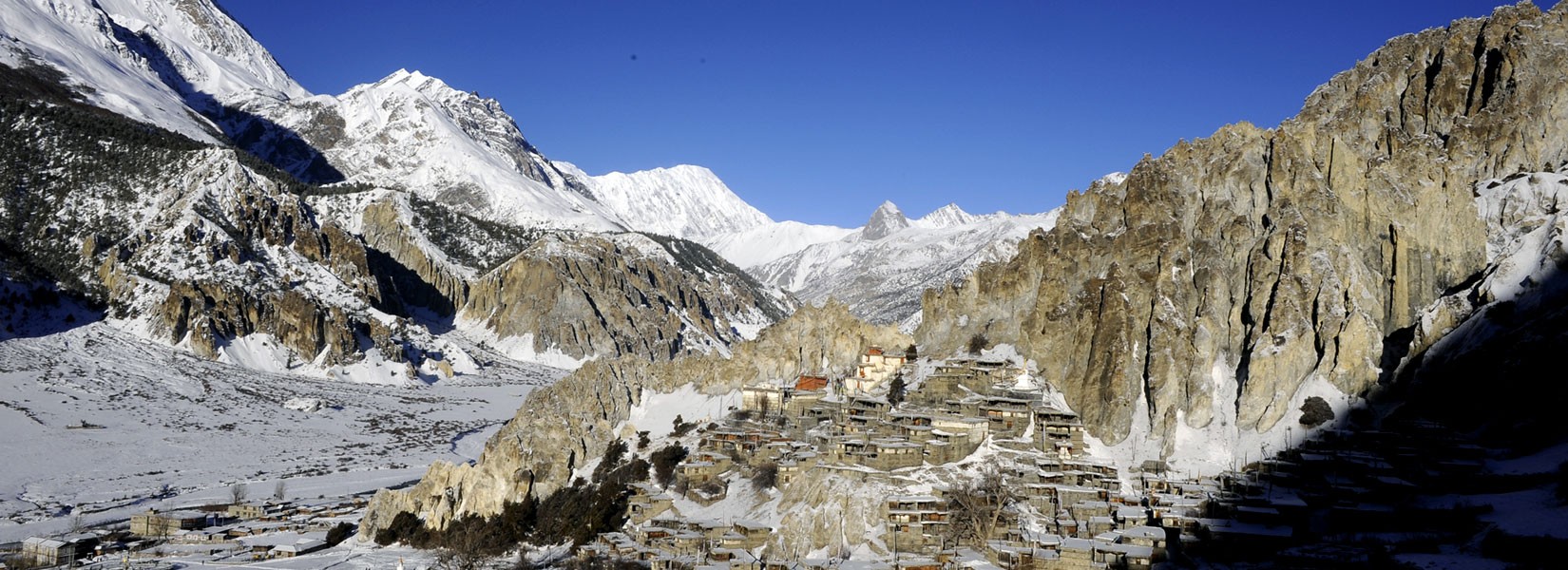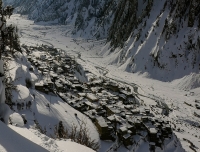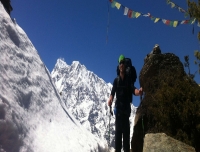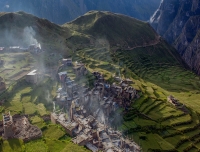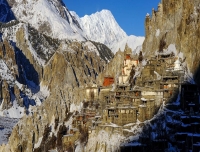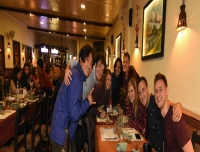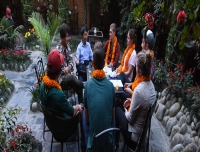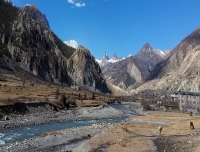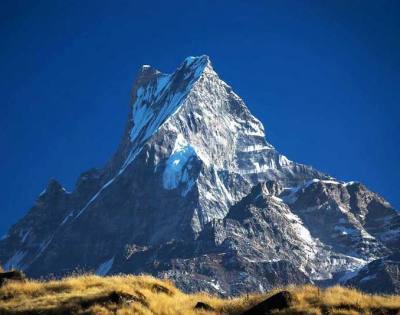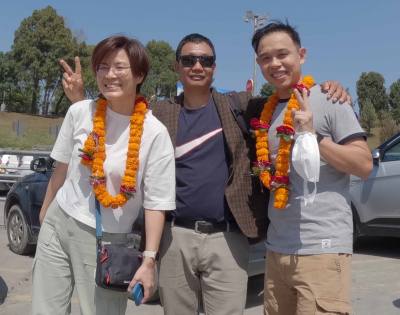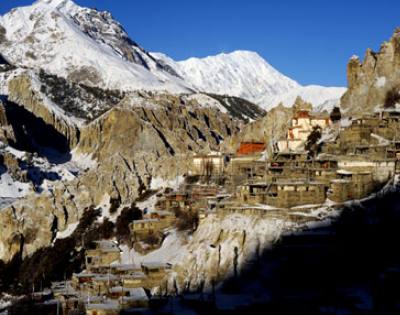- Read Reviews onTripadvisor
- Phone & WhatsApp Support+977 9851112535 (Chandra Shor)
Annapurna Classic Trek Thorang La Pass [5,416 meters / 17,769 ft] | 14 Days
Fact Information
- Duration
- 14 Days
- Destination
- Nepal
- Difficulty
- Moderate difficult
- Accommodation
- Hotel & Lodges
- Activity
- Trekking
- Transportation
- Tourist Bus, Car, Jeep, Air-plane
- Meals
- BLD (Breakfast, Lunch and Dinner)
- Max Person
- 18
- Min Person
- 1
- Maximum altitude.
- [5,416m/ 17,769 ft]
- Best season
- Autumn & Spring
About Trip
"Expect nothing less than breathtaking landscapes, rich cultural traditions, and a sense of heaven on earth."
The Annapurna Classic Trek with Thorong La Pass is a renowned trek that encircles the majestic Annapurna range, offering trekkers an opportunity to experience the diverse local ethnic groups of Nepal, such as the Thakalis, Magars, and Gurungs. However, the trekking duration has been shortened due to the construction of a new motorable road in Nepal. For those looking for an extended trekking duration, the Annapurna Classic trek can be combined with Tilicho Lake trek.
This trek is ideal for both trekking enthusiasts and those seeking spiritual fulfillment at the revered Muktinath temple. Nature lovers will be fascinated by the close-up views of peaks such as Annapurna I-IV, Gangapurna at 7,455 meters (24,458ft), Tilicho Peak at 7,134 meters (23,405ft), Dhaulagiri at 8,167 meters (26,794ft), Manasalu at 8,163 meters (26,781ft), and several other peaks ranging from 6,000 to 8,000 meters in altitude. The trek also offers stunning views of the Marshyangdi and Kali Gandaki river valleys.
As trekkers progress on the trail, they will encounter vibrant rhododendron forests, gigantic cliffs, dense subtropical forests, verdant hills, perennial rivers, and deep gorges. The Thorong La pass at 5,416 meters is the highest point of the trek, offering a great overall view of the Annapurna region.
Apart from the natural beauty of the trek, it also encompasses the enigmatic caves of Pokhara and cultural hubs of Kathmandu, Muktinath, and Jomsom, making it a truly multifaceted journey. The trek itinerary, provided by Himalayan Diamond Adventures, is flexible and can be tailored to your preferences.
Trip Highlights
Magnificent Views: The trek offers breathtaking views of the Annapurna range, including peaks such as Annapurna I-IV, Gangapurna, Tilicho Peak, and Dhaulagiri. Trekkers will also be able to see several other peaks ranging from 6,000 to 8,000 meters in altitude.
Cultural Experience: The trek offers an opportunity to experience the diverse local ethnic groups of Nepal, such as the Thakalis, Magars, and Gurungs. Trekkers will be able to observe their unique lifestyles, culture, and traditions.
Spiritual Experience: The trek offers a chance for spiritual fulfillment at the revered Muktinath temple, which is considered sacred by both Hindus and Buddhists.
Thorong La Pass: The Thorong La Pass at 5,416 meters is the highest point of the trek, offering a great overall view of the Annapurna region. It is a challenging and rewarding experience to reach the top.
Natural Beauty: The trek offers stunning views of the Marshyangdi and Kali Gandaki river valleys, vibrant rhododendron forests, gigantic cliffs, dense subtropical forests, verdant hills, perennial rivers, and deep gorges.
Enigmatic Caves: The trek also encompasses the enigmatic caves of Pokhara, cultural hubs of Kathmandu, Muktinath, and Jomsom, making it a truly multifaceted journey.
Aerial viewing flight: The journey concludes with an enchanting aerial viewing flight over the beautiful villages of Marpha and Kalapani, as well as the high pass of Ghorepani Poon Hill (3,110 meters), providing breathtaking views of the Himalayas, including Dhaulagiri and Annapurna - towering mountains.
Outlined Itinerary
Day 01: Arrival in Kathmandu 1,350 m (4,429 ft), transfer to hotel.
Day 02: Sightseeing of the UNESCO world heritage sites.
Day 03: Drive to Chame 2,670 m (8,760 ft) about 250km, 10 to 11hrs.
Day 04: Trek to Pisang village 3,200 m (10,498 ft) 4 hours.
Day 05: Trek Pisang to Manang 3,540 m (11,614 ft) 9 hours.
Day 06: Acclimatization Day in Manang with a wonderful side trip.
Day 07: Trek from Manang to Chuli Ledar 4,200 m (13,779 ft) 5hrs.
Day 08: Trek from Chuli Ledar to Thorong High Camp 4,925 m (16,158 ft) 4hrs.
Day 09: Trek over Thorong La pass 5,416 m (17,769 ft) descend to Muktinath
Day 10: Trek from Muktinath to Jomsom 2,720 m (8,923 ft) 7hrs.
Day 11: Fly to Pokhara 820 m (2,690 ft) transfer to hotel.
Day 12: Sightseeing around Pokhara valley.
Day 13: Drive back to Kathmandu 1,350 m (4,429 ft) 6 to 7hrs.
Day 14: Departure to Home.
Detailed Itinerary
Day 01: Arrival in Kathmandu Airport 1,350 meters (4,429 ft), transfers to hotel.
Representatives from Himalayan Diamond Adventures will greet you upon your arrival at Tribhuvan International Airport in Kathmandu. You will be welcomed with a fresh flower garland, a traditional Nepali greeting, and then escorted to the hotel for bed and breakfast service. The drive from the airport to the hotel takes approximately 15 to 20 minutes, if there is no traffic jam on our way. After checking into the hotel, we will have a short refreshment meeting at the hotel. In the evening, the company will host a welcome dinner at a traditional Nepali restaurant, complete with a cultural dance performance, to celebrate the start of your trip. During the dinner, your guide will provide a brief overview of the schedule for the following day.
Day 02: Valley sightseeing to UNESCO world heritage site.
Today, after breakfast, we will embark on a journey to explore some of the popular landmarks and milestones in the Kathmandu Valley, including several UNESCO World Heritage sites such as Pashupatinath Temple, Boudhanath Stupa, Patan Durbar Square, Swayambhunath Stupa, and Bhaktapur Durbar Square. Kathmandu is widely known as the city of temples and a cultural hub in Nepal. These places that we will visit today showcase the cultural and religious diversity of Nepal. Pashupatinath Temple is one of the oldest Hindu temples dedicated to Lord Shiva. Both Boudhanath and Swayambhunath are important sites for Buddhism and are visited by both Hindu and Buddhist followers. These places display the unique architecture, religious tolerance, and diversity that can be found in Nepal.
As Kathmandu has a huge historical history and carries cultural and religious essence a popular destination for tourists. The city presents a remarkable blend of Hinduism, Tibetan Buddhism via its heritage sites like Pashupatinath, Swayambhunath and Boudhanath. Our tour guide will provide you the relevant facts and historical significance of the places like Pashupatinath temple, the largest Buddhist stupa in town- Boudhanath, the 15th-century palace of 55 windows in Bhaktapur and Swayambhunath stupa in Kathmandu which we will visit today.
Day 03: A scenic bus journey to Chame 2,670 meters (8,760bft), about 250 kilometers, 10 to 11hrs.
A scenic bus ride from Kathmandu through Besishahar will take us to Chame, the headquarters of Manang district. The journey begins on the highly busy Prithibi highway and then links to the Beshisahar-Manang road. Along the way, we can enjoy splendid views of the mountain terrain, including the Ganesh Himal range, Baudha Himal, Rani peak, Himalchuli ranges, Ngadichuli, and Manasalu. Besides the majestic Himalayas, we can also see many beautiful perennial rivers, tributaries, captivating waterfalls, rolling green hills, subtropical forests, cultivated terraced lands, and colorful villages. After a 10 to 11-hour journey, we can stay overnight at a lodge in Chame.
Day 04: Trek to Pisang village 3,200 meters (10,498ft), 4 hours of comforting walk. Overnight in the lodge:
Today, we have two options to reach Pisang, an ancient Tibetan Buddhist inhabited village. One is to walk along the newly opened road, and the other is to take a jeep. If we take a jeep, we can reach there within 30 to 45 minutes, while walking will take us about 4 hours. However, our trail follows the narrow Marsyangdi river valley, providing stunning views of the enormous cliffs, including a superb view of Lamjung Himal and Annapurna II. As we leave the treeline, we will pass through large apple gardens, and the trail gradually ascends towards a place with a more prominent snowline.
Before reaching Pisang Village, we will be greeted with an iconic view of Pisang Peak, and Chulu East can be seen in the distance. After reaching Pisang, we can hike to Upper Pisang to gain altitude and enjoy breathtaking views, including mesmerizing views of Annapurna II (7,937 meters), Annapurna IV (7,525 meters), and Annapurna III (7,555 meters).
Day 05: Trek to Manang 3,540 meters (11,614 ft), along the upper viewing way, 8hrs.
Our destination today is Manang, a Tibetan Gurung village. The people of this Manang valley originally migrated from Tibet in the past. To reach Manang, we will take the upper panoramic viewing trail, which comprises isolated and peaceful villages like Ghyaru, Ngawal, and Chulu. At Pisang village, we will cross the Marsyangdi River over suspension bridges and then ascend to Ghyaru, a Tibetan primitive village. The uphill trail offers superb views of the Pisang valley behind us, including the majestic views of Annapurna II, Annapurna IV, Annapurna III, Gangapurna, and Tilicho. On a clear day, we will have truly breathtaking views. Although the upper trail is quite challenging, it is a rewarding trail as we trek through these ancient lands and sight Buddhist stupas, Buddhist Mani walls, and monasteries.
Day 06: Acclimatization Day in Manang; Explore Milarepa cave or take a hike Ice Lake or Gangapurna Lake:
Today is our acclimatization day, which is crucial after rapidly ascending in the mountains. We will rest at the same elevation to help our bodies adjust. On this day, we have the option to explore some interesting places around Manang Valley, such as the Marshyangdi River and Gangapurna Lake. Alternatively, we can hike up to Deurali (4,200 meters) for splendid views of Chulu West Peak and Chulu East (also known as Manang Himal), or take a side trip to Milarepa Cave or Ice Lake. Hiking up to Ice Lake offers delightful views of the wide Manang valley, Tilicho Valley, and the massive Annapurna Himalaya range while also aiding in altitude acclimatization. There are plenty of choices for tourists, and it would be great to have more days to explore the Manang Valley.
Day 07: Trek to Chuli Ledar 4,200 meters (13,779 ft), 5 hours gently uphill trail. Stay at the lodge:
Today, the trail will gradually ascend towards Tengki Manang, offering fine views of Manang village behind us, the crystal clear Marsyangdi river, and the greenish-blue Gangapurna Lake. We will continue trekking from the Marsyangdi River valley to Chuli Ledar Lodge, passing through the summer Yak grazing lands of Yak Kharka. The views are breathtaking with the Annapurna range and the snowy Tilicho Mountain beyond the Manang Himal. While trekking to the Thorong La pass, we might even spot some rare wildlife such as Snow leopards, Blue sheep, and Himalayan griffons on the way. After about 5 hours of relaxing and spectacular trekking, we will reach the Chuli Ledar Lodge, which is located at the base of the Chulu West peak.
Day 08: Push to Thorong High Camp 4,925 meters (16,158ft), 3 to 4 hours of relaxing walk.
Today is a relaxing day for us before we tackle the high pass of Thorong La at 5,416 meters. Our journey will begin by following a narrow and slightly inclined trail that crosses the suspension bridge over Kone Khola at the corners of Phedi. Along the way, we may come across rock fall zones and frozen streams during winter. Before we start climbing up, we will reach New Phedi, which overlooks the grazing lands of yaks and blue sheep. At the base of the High Camp, there are some tea houses where we can stop to eat and recharge our energy before the steep climb. From there, we will ascend uphill to the High Camp primitive lodge. The ascent can be challenging, but the stunning landscape makes it all worthwhile. At the High Camp, there is a small viewpoint that offers a substantial view of Chulu West trekking peak, which stands at 6,419 meters. Chulu West is a popular trekking peak in the Annapurna classic circuit trekking route.
Day 09: Trek out before the sunlight comes up to cross the Thorong La pass at 5,416 meters (17,769ft), and then descend to Muktinath at 3,760 meters.
Today, we will wake up early in the morning, around 5:00 A.M., and have a light, warm breakfast with a cup of tea. After breakfast, we will begin our ascent of the popular Thorong La pass at an altitude of 5,416 meters. The trail from High Camp gradually climbs the mountainside and after 3 to 4 hours, we will reach the pass, which is indicated by prayer flags and stone cairns. Note that the pass is usually snowbound during the winter season (mid-December to late February).
After enjoying the outstanding views from the highest pass of the Annapurna region, we will begin our descent to Muktinath. The trail steadily drops to Phedi, which is located at the bottom of the hill. Along the way, we will have wide, superb views of the Mustang valley and the eye-catching Khatungkang peak, which stands at 6,484 meters (21,273ft).
We will continue descending for 2 to 3 hours before stopping at Phedi for a hot lunch and some relaxation time. Afterward, we will resume our descent towards Muktinath, a holy shrine revered for salvation and spiritual fulfillment. Muktinath is a beautiful holy town.
Day 10: Trek to Jomsom 2,720 meters (8,923ft) 7 hours of a downhill walk with a splendid dry landscape to Kaligandaki.
Finally, we will trek down to the base of the Kali Gandaki River, passing through Jharkot and Kagbeni, which serve as the main entry gateways to the Upper Mustang Valley. As we trek down, we will be treated to breathtaking views of cultivated lands, hills, Tilicho, and Nilgiri, providing an unforgettable trekking experience. After sightseeing in Kagbeni village, we will continue our trek to Jomsom, the headquarters of the Mustang district, following the Kaligandaki River. After 7 to 8 hours of trekking from Muktinath, we will finally reach the windy valley of Jomsom, one of the best tourist destinations in Nepal.
Day 11: Scenic flight; Jomsom to Pokhara 30 minutes 820 meters (2,690ft) transfer to hotel.
Early in the morning, we will take a 30-minute scenic flight from Jomsom to Pokhara, which offers breathtaking views of the Annapurna (8,091 meters), Dhaulagiri (8,167 meters), Nilgiri (7,060 meters), Annapurna South (7,219 meters), Machhapuchhre (6,997 meters), and other stunning mountains. Alternatively, we can take a Jeep from Jomsom to Beni and then travel by micro bus from Beni to Pokhara to reach our destination in a single day. We will spend the night at a lodge in Pokhara.
Day 12: Full day sightseeing around Pokhara valley like Peaceful stupa, David falls.
There are various activities to enjoy in Pokhara, such as mountain flights, paragliding, boating, cycling tours, motorbiking tours, etc. However, we will be taking a sightseeing tour around Pokhara. We will visit the Peace Pagoda (also known as the Peaceful Stupa), Barahi Temple in Lakeside, enigmatic caves, Davis Waterfall, and the International Mountain Museum.
Day 13: Fly to Kathmandu 1,350 meters (4,429 ft), and transfer to hotel.
Today, we will fly back to Kathmandu after our lunch hour. While taking off from Pokhara International Airport, you can enjoy breathtaking views of the surrounding mountains in clear weather. Before landing at Kathmandu Tribhuvan Airport, you will also have the opportunity to enjoy sensational and spectacular mountain vistas. Upon arrival, we will shuttle you in a private car or tourist bus to your hotel, where breakfast will be served. In the evening, we will have a welcome dinner at a Nepali cultural restaurant with traditional Nepali dance performances..
Day 14: Departure to Home.
We will drop you off at Tribhuvan International Airport before your scheduled check-in time for your international flight. We will be there to see you off.
Note: - that the outlined itinerary is designed for those who prefer a full package service. However, we understand that preferences and time constraints may vary, so we offer the flexibility to customize the itinerary according to your needs. The selection of itineraries and staff will be based on your specific requirements and budget. Additionally, we have options available for partial visits to accommodate your preferences and financial situation.
Cost Details
What's included
- 1. Airport pickup and drop-off via a private vehicle as outlined in the itinerary.
- 2. Three nights of deluxe accommodation with a shared room at either Hotel Moonlight or Kathmandu Guest House in Kathmandu Thamel, including breakfast service.
- 3. A full day of sightseeing in the Kathmandu Valley, covering UNESCO World Heritage sites, with a city guide, transportation, and all entry fees for UNESCO world heritage temples.
- 4. Two nights of deluxe accommodation with a shared room at Hotel Trekker Inn or Hotel White Pearl in Pokhara, including breakfast.
- 5. A day of sightseeing in Pokhara with a guide, private transportation, and all entry fees for museums and temples.
- 6. Inclusion of permit fees for the Annapurna Conservation Area Project and Trekkers’ Information Management Systems (TIMS).
- 7. Flight fare from Pokhara to Kathmandu with a 15 kg cargo service allowance.
- 8. Three daily meals, including a customizable menu (breakfast, lunch, dinner, and dessert) and hot beverages such as coffee, tea, hot lemon, ginger lemon tea, ginger lemon honey, and hot water.
- 9. Accommodations in Mountain clean and comfortable hotels, lodges, and tea houses.
- 10. An experienced, knowledgeable, and friendly English-speaking guide with a government license, covering all expenses related to salary, food, drinks, accommodation, transport, and insurance.
- 11. Provision of an assistant trekking guide for groups with more than 6 members or as per client requirements.
- 12. One strong and helpful porter assigned for every two members, equipped with proper gear, including a Gore-Tex jacket/trousers, trekking shoes, woolen hat, woolen gloves, woolen socks, and sunglasses, among others.
- 13. Insurance coverage for Nepalese staff, including emergency rescue evacuation by helicopter, hospitalization, medical treatment, and accidents.
- 14. Availability of medical supplies, including a first aid kit, with oximeter readings of pulse, oxygen saturation, and heart rate taken twice daily to monitor symptoms of Altitude Mountain Sickness (AMS).
- 15. All ground transportation provided, including a private jeep from Kathmandu to Besisahar to Chame.
- 16. Available airport pickup and drop-off services in Pokhara.
- 17. Post-tour airport pickup service for transportation back to your Kathmandu hotel.
- 18. Complimentary items provided by the company, including a duffle bag, map, and company T-shirt.
- 19. Hot bag services.
- 20. Inclusion of government taxes and official expenses.
- 21. Arrangement of Emergency Helicopter service, with the cost covered by your Travel Insurance company.
- 22. Rental services available for down-filled jackets, sleeping bags, mini crampons, and trekking poles, with a fee of $5 per day for laundry service and maintenance.
- 23. Welcome dinner and farewell dinner at Nepali cultural restaurants.
What's not included
- ❖ Personal trekking equipment and gears.
- ❖ Nepal entry visa fee.
- ❖ International airfare bill.
- ❖ Extra night accommodation in Kathmandu because of early arrival, late departure, early return from mountain (due to any reason) than the
- ❖ Meals while you stay in Kathmandu Hotel Lunch and Dinner.
- ❖ Your travel insurance policy should be covered rescue evacuation, medical treatment and accidental.
- ❖ Any entry fee for the temple or monastery.
- ❖ Donations or charity.
- ❖ Your personal expenses like; Hot shower, Laundry, Battery charging, telephone, WIFI, and shopping, etc.
- ❖ Alcoholic and non-alcoholic alcoholic hot and cold drinks.
- ❖ Tips for the guide, porter, and driver (tipping is expected)
Useful Info
What Essential Documents Do I Need To Bring With Me On Tour?
When going on a tour, it's important to bring essential documents to ensure a smooth and hassle-free trip. Here are some documents that we highly recommend you bring with you.
Passport: When traveling to a foreign country, it is important to ensure that you have a valid passport with at least 6 months validity remaining before its expiration date and at least 2 blank visa pages. This is because many countries require that your passport is valid for at least six months beyond your expected departure date and has sufficient blank pages for visa stamps and entry/exit stamps.
Visa: Depending on your destination, you may need a visa to enter the country. Check with the embassy or consulate of the country you're visiting to see if you need a visa. Visit the official website of the Department of Immigration of Nepal at https://www.immigration.gov.np/page/tourist-visa
Travel itinerary: It's always a good idea to have a printed copy of your travel itinerary, including flight and hotel reservations, tour bookings, and any other important travel plans.
Travel insurance: As a traveler, it is advisable to purchase a comprehensive travel insurance package that covers potential medical issues, personal accidents, emergency helicopter evacuation, loss or damage of personal belongings, and trip cancellations, especially if you are planning to trek to high altitudes up to 5,500 meters, such as Everest Base Camp. It is also important to ensure that the insurance covers the cost of cancellation for both your international flight and the trek. The minimum recommended coverage amount is USD 100,000. Many insurance companies offer travel insurance services online, so you can easily find a plan that meets your needs.
COVID-19 vaccination certification: To obtain a Nepal tourist visa during the ongoing pandemic, travelers need to show either a completed COVID-19 vaccination certificate with a QR code or a negative PCR test result taken within 72 hours of boarding.
Health documents: If you're traveling to a country with specific health requirements, such as a yellow fever vaccination, make sure to bring the necessary health documents.
Driver's license: If you plan on driving while on tour, make sure to bring your driver's license.
Credit cards and cash: Bring enough cash and credit cards to cover your expenses while on tour.
Emergency contact information: Write down the contact information for someone you trust in case of an emergency. This could include a family member, friend, or employer.
It's always a good idea to make copies of all your important documents and keep them in a safe place in case the originals get lost or stolen. Additionally, you may want to consider using a travel document organizer to keep all your important documents organized and easily accessible.
If you are traveling to Nepal, then here are some essential documents you will need to have with you in order to ensure a smooth and hassle-free trip.
What Essential Documents Do I Need To Bring With Me For Annapurna Classic Trek?
❖ Valid passport with at least 6 months validity and at least 2 blank visa pages
❖ Travel insurance policy document
❖ Photocopies of your passport's personal information page
❖ One or more recent passport-sized photos with a white background (1.5 inch x 1.5 inch)
❖ Completed and signed Nepal visa application form
❖ Proof of accommodation in Nepal (such as a hotel reservation or address)
❖ Valid return flight or travel ticket
❖ Proof of sufficient financial means, such as recent bank statements
❖ Mastercard, Visa, and some cash in USD
❖ Proof of payment of the Nepal visa fee
❖ To obtain a visa for Nepal, your passport must be valid for at least 6 months from the travel date and you must present either a completed COVID-19 vaccination certificate with QR code or a valid PCR test negative result taken within 72 hours prior to boarding.
How to apply for an online tourist visa to Nepal?
Visit the official website of the Department of Immigration of Nepal at https://www.immigration.gov.np/page/tourist-visa
1. Fill out the online application form with your personal information, including your name, date of birth, nationality, passport number, and intended travel dates.
2. Upload a recent passport-size photograph in JPEG or PNG format.
3. Pay the visa fee online using a credit card or debit card. The cost of the visa depends on the length of your stay in Nepal, but it typically ranges from $30 to $125.
4. Once you have submitted your application and payment, you will receive a confirmation email with a receipt and an application ID.
5. After your application has been processed, you will receive another email with a link to download your visa. You should print out the visa and carry it with you when you travel to Nepal. It's important to note that the online tourist visa is valid for multiple entries and is valid for 15, 30, or 90 days, depending on your length of stay. Also, be sure to apply for your visa well in advance of your travel date to allow time for processing.
What Type Of Insurance Should I Get?
It is essential for foreign travelers to secure insurance coverage while trekking or climbing in Nepal. Although trekking in Nepal is generally safe, travel insurance is compulsory for mountaineering activities in Nepal. The trip can pose physical challenges and hazards, particularly at high altitudes where altitude sickness is prevalent among trekkers and climbers, especially those who have not acclimatized properly. Physical injuries can also occur on mountain trails or during climbing activities, and in emergency situations, foreign trekkers or climbers may need to be rescued by helicopter and transported to hospitals in Kathmandu, which can be costly if the traveler does not have insurance coverage.
We strongly recommend purchasing a travel insurance package that covers high altitudes up to 5,500 meters, potential medical issues, natural disasters, personal accidents, emergency helicopter evacuation, hospitalization, loss or damage of personal belongings, and trip cancellations. The minimum recommended coverage amount is USD 100,000. There are many insurance companies that offer travel insurance services online. You should compare plans to find the one that best meets your needs.
What Are Some Popular And Highly Rated Travel Insurance Companies?
If you are in search of popular and highly-rated travel insurance companies, then we can recommend some based on positive feedback we have received from our previous travelers. It is here. [Company 1], [Company 2], [Company 3]............................
For Travelers from USA and CANADA.......................https://www.worldnomads.com/row/travel-insurance.
Online Global Health Insurance
Travelex
Insure My Trip.com (Online Insurance Aggregator)
Mondial Assistance
Access America
HCC Medical Insurance Services
Good Neighbor Insurance (International Health)
International Health
Insuremytrip dot com
MultiNational Underwriters
TIC Travel Insurance Coordinators Ltd
Travel Assist
TraveLite
For Travelers from England...................................
Specialty Group (UK) Limited
FirstAssist Services Limited
Harrison Beaumont
Buy cheap travel insurance
For Travellers from EUROPE and SLOVENIA...........................
Assistance CORIS
For Travellers from AUSTRALIA and NEW ZEALAND
Cover More Travel Insurance
CGU Insurance Limited
For Travellers from SOUTH AFRICA........................................
Travel insurance Consultants Pty. Ltd.
What are the weather conditions and temperatures like in Nepal?
As Nepal's topography is divided into three geographical regions - Terai, Hills, and Mountains - each region experiences different temperatures during different seasons. Below is a tabular illustration of temperature changes throughout the different seasons in Nepal, which will allow you to better understand the changing weather conditions.
Seasons Minimum temperature (approx) Maximum temperature (approx) Weather Condition
Spring 4°C/ 39°F (Mountain) 20°C/ 68°F (Mountain) Moderate with occasional rain
Summer 12°C/ 53°F (Mountain) 25°C/ 77°F (Mountain) Extreme high with heavy rain
Autumn 3°C/ 37°F (Mountain) 18°C/ 64°F (Mountain) Moderate
Winter 10°C/ 50°F (Terai) -4°C/ 24°F (Mt.) 20°C/ 68°F (Terai) to 12°C/ 53°F (Mountain) Extreme low
What Is The Best Time To Trek In Nepal?
After a thorough analysis of all the seasons, it has been suggested that autumn is the best time of the year to trek in Nepal. The mild temperatures from September to November make the trekking experience more enjoyable. During this time of the year, trekking routes throughout the country are jam-packed with travelers from all around the world.
However, as mid-December is generally the holiday season in most countries, including the United States, there is a spike in the number of international tourists during early winter as well. Interestingly, to make the holiday season even more special, travel companies offer some of the best holiday destination packages during this time. So, be sure to take advantage of the best travel opportunities with the assistance of Himalayan Diamond Adventure.
Nonetheless, if you cannot make it in autumn, spring also allows for favorable conditions for trekking in Nepal. The warmer days and nights, lush plants and vegetation, and clear trekking trails during spring make the trek worthwhile. However, the downside is occasional rain and slightly higher temperatures in the lower elevations. All in all, after autumn, spring is the second-best time to trek in Nepal.
Best time to trek in Nepal:
Thousands of tourists visit Nepal every year to enjoy the picturesque nature and trek through the adventurous and diverse terrain. However, the best times to trek in Nepal are autumn (September to November) and spring (March to May). During these seasons, travelers are blessed with moderate temperatures and enjoyable weather conditions throughout the country.
As calm as it may seem, the challenging terrains of the Himalayas in Nepal can present trekkers with gruesome scenarios during harsh weather conditions. To avoid any unforeseen situations and to enjoy nature at its best, most trekkers prefer autumn for backpacking. However, it may not be the best time of the year to trek in Nepal for everyone. Some may prefer off-season trekking to avoid the crowds. Therefore, exploring the various seasons can help you choose a favorable time for trekking in Nepal based on your preferences.
Trekking Seasons in Nepal
Throughout the year, the landscape of Nepal experiences four seasons, each with its own uniqueness that brings significant changes to the natural environment. Below are some detailed insights into the four seasons in Nepal.
1. Spring Season (March-May)
Spring in Nepal lasts from March to May and is one of the preferred seasons for trekking throughout the country. During this time, the climate is moderate, with slightly higher temperatures reaching up to about 32°C (89°F) in the lower elevation regions and around 20°C (68°F) at higher altitudes. The sky is usually clear with mild days and occasional rain.
Spring brings a rejuvenation of nature. Flowers begin to blossom, trees become lusher with newly sprung leaves, and spring vegetation sprouts again. Likewise, the flora and fauna of the Himalayan terrain also resuscitate from the harsh winter. Overall, spring is considered a great time for trekking in Nepal due to the alluring freshness of nature.
2. Summer Season (June-August)
With the end of May, summer starts in Nepal and lasts from June to August, which is also the monsoon season in the country. During these months, the weather can be harsh, with scorching heat and heavy rain throughout the nation. The rising humidity and extreme hot weather conditions may restrict travelers from fully enjoying their trip.
Although the lower elevation regions experience harsh summers, the Himalayan terrains are not as brutal. In the mountain regions, temperatures can range from approximately 25°C to 12°C (77°F to 53°F). However, heavy rains can make trekking through rocky mountain terrain challenging, and the cloudy sky may obscure mountain views.
3. Autumn Season (September-November)
With the arrival of autumn from September to November, Nepal becomes a popular destination for trekking. During this season, the weather is usually pleasant with clear skies, moderate temperatures, and gentle sunshine throughout the day. However, early autumn may bring occasional light rainfall. As the season progresses into October and November, the monsoon season completely ends, and cooler weather conditions prevail.
Many people choose to trek to popular destinations such as Everest Base Camp, Annapurna Base Camp, and Poon Hill during this season. Additionally, autumn is festival season in Nepal, and visitors can witness major celebrations such as Dashain and Tihar, which provide an opportunity to experience Nepali culture and traditions. Many travel packages are available for the best treks in Nepal during this season, and our travel experts can help you plan your trip to align with the festival season.
4. Winter Season (December-February)
Winter, which lasts from December to February, is the harshest season for trekking in Nepal. As the temperature drops in December, nights become chilly, and temperatures can reach around 9°C (48°F) during the day and below 0°C (32°F) during the night in higher altitudes. During peak winter, many high passes and trekking routes in the mountains are covered with dense fog and snow, increasing the risk of unexpected accidents.
Because of the risks of unpleasant trekking conditions, most travelers avoid trekking in the Himalayan terrains during the winter season. Additionally, most expeditions and mountain climbing, including trekking in the Everest region, also come to a halt during the harsh winter. Overall, it may not be the best time to trek due to the challenges presented by the weather conditions.

